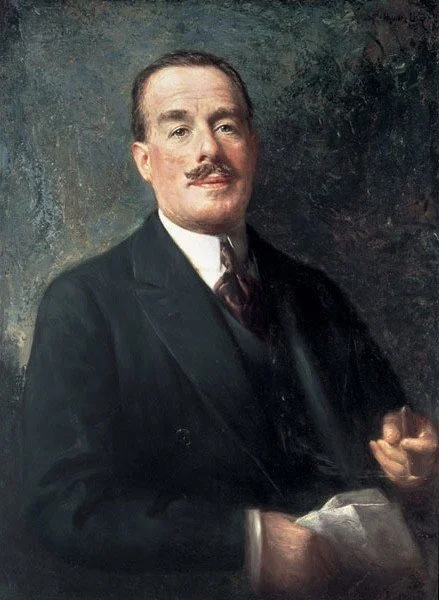The Groove 237 - The Myth of the Art Collector’s “Good Eye”
Welcome to the 237th issue of The Groove.
I am Maria Brito, an art advisor, curator, and author based in New York City.
If you haven’t done so, please subscribe here, to get The Groove in your inbox for free every Tuesday.
THE MYTH OF THE ART COLLECTOR’S “GOOD EYE”
The legendary Joseph Duveen painted by Adolfo Muller Ury in 1923. Duveen was the art dealer and advisor who developed the eye of collectors like Andrew Mellon and Henry Clay Frick..
Even the most legendary collectors didn’t go it alone, and you shouldn’t either because taste isn’t magic. It’s built with guidance and education.
People love the myth of the “good eye” - that someone can just see genius before anyone else, as if it’s a supernatural ability that these folks possess, granted by divine design. But in reality, great taste isn’t a superpower. It’s a process. And often, it’s a partnership.
Here’s how some of the greatest art collections came to be:
Joseph Duveen and the American Industrialists (Early 1900s–1940s)
If anyone disproved the myth of the genius solo collector, it was Joseph Duveen. The British-born art dealer shaped the tastes of America’s early 20th-century elite; guiding them toward Old Masters and European masterpieces with long-term value and cultural gravitas.
His clients weren’t amateurs. They were tycoons like Henry Clay Frick, Andrew Mellon, and J.P. Morgan, whose collections now form the backbone of major U.S. museums. Among many other acquisitions, Duveen:
• Sold The Adoration of the Sheperds (1505-1510) by Giorgione to Samuel Kress,the New York entrepreneur who pioneered the dime-store retail chain. Kress later donated it to the National Gallery of Art in Washington, DC.
• Sold Rembrandt’s Aristotle with a Bust of Homer (1653) three times, including to his client Alfred W. Erickson, who was the co-founder of McCann Erickson, a global advertising agency network. Aristotle with a Bust of Homer is now part of the permanent collection of the Met in New York.
• Helped Frick acquire Vermeer’s Mistress and Maid (1666-67) in 1919 for $290,000, which still remains in the Frick Collection to date.
These men didn’t have time to study every book and nuance of art history; there weren’t even illustrations of these objects and everything was from Europe. But they had Duveen, who shaped not just their collections, but America’s cultural institutions.
Albert C. Barnes and William Glackens (1912–1920s)
Albert Barnes, a Pennsylvania chemist and entrepreneur, built one of the world’s greatest collections of modern art. But he didn’t do it alone.
In 1912, Barnes sent his old friend, artist William Glackens, to Paris with $20,000. Glackens returned with 33 paintings by Cézanne, Picasso, Van Gogh, Renoir, and others: works that launched Barnes’s collecting journey.
Later, Barnes deepened his holdings with help from French dealer Paul Guillaume, through whom he acquired works like Le bonheur de vivre (1905-1906), one Matisse’s most important paintings (and one that generated such envy in Picasso that he produced Les Demoiselles d’Avignon to topple Matisse) as well as many canvases by Modigliani and Soutine.
Barnes’s legacy is not just in his “eye”, but in the fact that he asked for help to build a world-class collection.
Solomon Guggenheim and Hilla Rebay (1930s–1940s)
When Solomon R. Guggenheim began collecting, he favored traditional landscapes and still lifes. That changed dramatically after he met Hilla Rebay, a German aristocrat, artist, and evangelist for a brand-new genre completely unknown to Guggenheim: abstract painting.
Rebay urged Guggenheim to embrace abstraction and modernism, particularly the work of Wassily Kandinsky, whom she considered a prophet. Under her guidance, Guggenheim acquired more than 150 works by Kandinsky; including Composition 8 (1923), still a cornerstone of the Guggenheim Museum today. Paul Klee, March Chagall, Robert Delaunay and many others were systematically added to Guggenheim’s personal collection following Rebay’s guidance.
Rebay shaped not only Guggenheim’s tastes but the identity of one of the most famous museums in the world.
The Real “Good Eye” is Humility, Not Instinct
What unites these collectors isn’t innate genius. It’s the humility to admit they don’t know everything, the curiosity to learn, and the confidence to act on expert advice.
• Duveen’s clients didn’t see Old Masters as fashionable, but they trusted his vision.
• Barnes didn’t try to wing it; he hired his artist friend and then a Paris dealer to guide him.
• Guggenheim didn’t pretend to understand abstraction; he let Rebay shape his journey.
The real “eye” is built over time. With education. With advisors. With intention.
If you want to build a collection that stands the test of time, don’t rely just on “gut feeling” without having a true education of why what you are looking at is worth getting. Don’t go trend-chasing alone. Do what the greats did: partner with someone who knows how to see, think, and guide like a museum curator and strategist.
That’s what I do. Let’s make your collection one for the history books.

